Stories
The Legend Of General Mociulschi
From Russia to Berlin, a forgotten Mountain Hunter fought for freedom
From the long list of forgotten heroes of the Romanian people, brought to an unfair state of annonimity, either by a Soviet-pressued communist government, or by our own and cheap habbit to despize and forget our great past, comes one who has been nicknamed "the legendary commander".
General Leonard Mociulschi, a real life tactical genius and brilliant commander, was rising in rank during the 1920's and 30's. It's in this period that the leader, now in command of ever increasing Mountain Hunter units, formed and trained his men, men who, in just a decade's time, will make "the best in the world" soldiers run for their lives on the battlefield.
After taking command of the VM unit in Sighetul Marmatiei (N-W Romania), he plans and conducts douzens of tactical applications, throughout the Maramures mountains (N-W Romania).
World War Two came, uninvited, to Romania, in the 22nd of june, 1941. Previously, the nazi rules of Germany (Adolf Hitler) and Hungary (Miklos Horthy) have split Romania like a piece of cake, taking away northern Transylvania and attaching it to Hungary.
The Mountain Hunters had to retreat in front of the enemy, giving up the land without a fight. For the time.
In the 22nd of june 1941, the now Brigadier General Leonard Mociulschi leads the Mountain Hunters for the liberation of Basarabia and Bucovina, the two Romanian provences in the E of the country, that have been anexed by the Soviets just two years earlier.
It is pointless to describe in detail all the victories won by the General and his men; it would take too long. Northern Bucovina, Basarabia, the Calmuca steps, the Caucasus mountains, Stalingrad, etc.
General Gheorghe Avramescu, the supreme commander of the Mountain Corps, calls Mociulschi "a terrific fighter and an excelent organizer".
When the right time arrived, in the 23rd of august 1944, Romania turned its weapons against the nazi invaders. The newly promoted Division-General Leonard Mociulschi now received the command of the 3rd Mountain Hunters Division. It was finally the time to free the two and a half million Romanians which have been under a constant extermination process by the Hungarian military. The Hungarian Army's occupation of Northern Transylvania proved to be a Romanian version of the Holocaust. The Hungarians are renouwned for their habbit of taking out the body of an unborn child, right from his mother's woumd, with the bayonette, thus killing both of them in a horrible display of nomadic barbarism. Also, Hungarian soldiers roamed the land, and in every village they encountered, the Romanians were gathered together, put to dig their own graves, and then burried alive. In a typical display of cynism, the Hungarian soldiers then covered the mass graves with lime, so the smell of decay would be more 'bearable'. It probably took hours, or even days, for all the people to suffocate or die of hunger, burried alive in their own villages.
The Huns, nowadays called "Hungarians", are the most barbaric tribe ever recorded by history. They are the reason why the Chinese built the Chinese wall: it was to stop these Mongolic tribes to repeatedly attack China from the north. After the Chinese have built their wall, the Huns, or Hungarians, now came from their homeland of Mongolia, all the way to Europe, reaching havoc throughout its territory, all the way to the Gibraltar.
The Romanian ancestors, the Dacs, were the only tribe that they did not conquer. The gold rich country of Dacia had become a prime target for the Huns, a goal that they never did gave up.
But all these atrocities, conducted by Miklos Horthy, the ruler of the Hungarian Nazi party, were about to come to an end.
Divison-General Leonard Mociulschi had arrived from Stalingrad with his 3rd Mountain division, straight back to Transylvania. In the battle of the Valley of Crisul Negru, his severely outnumbered forces manage to repell a powerful German-Hungarian counteroffensive. The Germans, which are called everywhere the best soldiers of World War II, in a high numerical superiority, together with the Hungarians, were pushed back towards the Tisa river (former in ancient Romania, nowadays in central Hungary). The city of Oradea, today at the western border of Romania, was re-taken much earlier than planned.
The Hungarians in their own turn have had enough of Miklos Horthy and his dying nazi regime. Horthy sent 350,000 Hungarian soldiers to the German-led invasion of the Soviet Union, in exchange for Hitler's order to attach Northern Transylvania to Hungary. Many of the Hungarian soldiers, poorely trained and equipped, have been used like the Romanian and Italian ones, as a frontline buffer during the invasion. Now, the Mountain Hunters are pushing on. The German armies, now on retreat towards the river Tisa, and under herassment by both Serb and Hungarian partizans, fought dearly for the keeping of Debretin (Debrecen, E Hungary) and Budapest (capitol city, N-central Hungary). The Mountain Hunters however manage to smash the German resistance and liberate the two cities, and later the entire country of Hungary. Go back to the history section to see pictures of Romanian soldiers giving hot meals to Hungarian civilians, on the streets of Budapest. And to think, that this comes after the Hungarian soldiers have comitted all those atrocities against the Romanian civilians.
Later on, Division General Leonard Mociulschi passes the border into Czechoslovakia, attacking the Tatra mountains, another strong-hold of the retreating German forces. The German Army Group Center felt the power of the spearhead which was the Romanian 3rd Mt Division. However, in the 8th of April, 1945, while the 3rd Mt Division was nearing Prague, Mociulschi receives an order to immediately return to Romania. Other Romanian major units will continue the fight and reach Viena and later Berlin. The Russians burned the archives and as such, if one visits Hungary or Czechoslovakia today, at the entrance of each village stays written "This village was liberated by the Soviet Army". Romanian veterans going to Budapest for a ceremony were outraged. "That's impossible, I fought here!", says one 86-year old officer. "I fought here and there was no Russian foot around for miles !!!", he continues.
But the returning general was not received with military honours, nor with hand-shakes, when he stepped back on Romanian soil. After being ruled by pro-German governments, Hungary and Romania now have new, communist governments. Due to the great pressure of Moscow, both of them step asside any past conflicts and behave, on the surface, as good communist comrades. For sure, someone like Mociulschi, who lead his Mountain Hunters almoust all the way to Moscow, is now a political embarassment. And the Soviets want him. The Soviets behaved more or less the same as the Hungarians, when they entered Romania. But they made no mass graves, no extermination, and no wipe-out plan. However, a large number of people were superficially executed by ad-hoc judging parties. One of them was Marshal Antonescu, the leader of Romania at that time. The Russians did engage in mass raping, stealing and torture. Perhaps it should be 'understandable', if one looks at their experience with the Germans, when they too, were invaded by them. Basarabia and Bucovina have been ripped off from Romania and attached to the Soviet Union, which now represents more than sixty percent of Romania's border. All the factories were dis-assembled and sent by train, to Russia. General Mociulschi is sent to jail for one year. After that, an ad-hoc "People's Tribunal" remarcably finds him 'not guilty', and by the Court's Order No. 18, from the 31st of may 1946, he is aquitted. I say 'remarcably' because the People's Tribunal was of course, a mock judging authority meant only to quickly execute people.
58 years old and after 40 years in service, "the legend" who fought and achieved remarcable victories in two world wars is now seeking a job in a country that has to pay a multi-billion dollar war payment to the Soviets, even after a quarter of its territory was already anexed by them and all its factories were deported to Siberia.
But this situation would not last long. From bad to worse, during 1948 he is again arrested, this time without a trial. Still with no trial nor any kind of conviction, the communist authorities send him to force labor camps, working in places like the Danube-Black Sea cannal, Onesti and Castelu. After this detention, he is again freed, with no further comments, in 1955.
Times have changed for the Mountain Hunters. The ones who once roamed from Moscow to Berlin, from Stalingrad to the Tatra mountains, are now looking for a job, any job. Leonard's former chief of staff, sacked and therefore still ranked as a colonel, Petrescu, was selling his decorations in the markets of Baia Mare (capitol of the Maramures region, N-W Romania), the former battlefield, in order to have money for bread. General Mociulschi, now a civilian, works on the lowest jobs. The state that he once served, has betrayed him.
Commander of large units of the Mountain Hunters, victorious in strips of land that are longer than Europe taken from one tip to the other, decorated twice with the Mihai Viteazul order and with over a hundred other orders and decorations, has passed away without nobody even noticing it. Like him, many more, have been deprived even of a decent burial, due to, of course, 'lack of funding'.
In 1999, 20 years after his annonymous death, the local military organization in Baia Mare has replaced its display panel at the entrance. The new one states, near by "COUNTRY, HONOUR, DIGNITY", the name of Division General Leonard Mociulschi.
A Mountain Hunter on Everest
The famous loyalty of the VM's and a remarcable story about humanity
After many years of mountain climbing in the military, and personal hiking trips in the amazing Romanian mountains, conquering peaks such as the ones from Fagaras or Bucegi, lieutenant Daniel Pisica got to be a member in the select group of Romanian mountain climbers. Also experienced in climbing peaks in far away continents, lt Pisica was one of the men who Defence officials thought of when they planned sending a soldier to the Romanian mission to Everest, at the 50th celebration of its conquest.
"God wanted that to be me", said lt Pisica.
No gear, no deal
After the Defence Ministry had approved his departure, the youngest member of the team, lt. Daniel Pisica, started to look for proper equipment. Not a problem for climbers from countries like US or Switzerland, who spend tons of money in a douzen expeditions and still don't bring any results back home, the cost of the gear was the first obstacle in front of this mission. A simple pair of Lorpen sox costs around $50. And there's also tents, termarest, gore-tex, sleeping bags, boots, safety belts, communication equipment, taxes, etc. In total, 3,000 euros to say the least.
There is a funny saying among Romanian climbers today: "In the 1960's, sex was safe, and climbing - unsafe. In the 2000's, climbing is safe, but sex - unsafe".
The 14 members of the expedition left Romania on March the 27th, 2003, from Otopeni International Airport, North of Bucharest, and after a hop in Viena, a city craddled with smog, pick-pocketers and armed guards, landed in Kathmandu, the capital city of Nepal.
The Romanian team had the lowest budget of all the teams attempting to conquer the peak this year, however they did managed to achieve their goal. Not the same can be told about the Swiss team for example, which had an exagerrated budget even for their own standards, no less than 30 times larger than the Romanian team's budget. However, their performance was that they couldn't even get above Base Camp, but curiously enough, were greeted at home like 'heroes'.
From the 1,350 m altitude of Kathmandu, the climbing had to be made slowly, due to the fact that above 3,500 m, the human body needs to get used to the pressure changes and lack of oxygene, thing called 'aclimatisation'.
After their arrival in Kathmandu, the group increased by three members: Gheorghe Dijmarescu, a Romanian climber who has been living for 20 yrs now in the US, his wife, Lapka Sherpa, a world champion and the only woman to climb the Everest three times, and their 16-year old daughter, Dony Sherpa, who even at this young age already proved that she carries her parents genes.
The storm - a curse, the accident - bad luck
During the climb, a sherpa gets pulmonary endem. Being the youngest, and also a Salvamont member, he decides to accompany him down to Base Camp, knowing very well that the person doing that would probably miss the ascention to the peak.
Lt. Pisica goes down the mountain with the injured Dyly Sherpa, thru the storm, arm to arm, as the sherpa could bearly walk. The road that was supposed to take 10 hours, now took 16. In the end, lt Daniel Pisica saved Dyly Sherpa's life. However, in the mean time, the climbers which were still on top got a window of opportunity, and they took it. Good weather came for a brief moment, and some of them have climbed the peak. The three "Americans" and three members of the group.
And that was it.... waiting your entire life to climb the top of the world, when misfortune happens. One more proof, if ever needed, of a Mountain Hunter's famous loyalty. Lt. Daniel Pisica got as high as 7,200 meters, and in the end, he saved a man's life. "And isn't that the supreme duty?", he asks in a bitter-sweet smile. Back to Kathmandu, Dyly Sherpa was very giving with beer and good words. His new friend and rescuer, a Romanian Mountain Hunter, left his own life-long desire to climb the peak, in order to save his life.
"If God helps me and I will be healthy, I will get, one day, ON TOP! For now, I have just made one 'assault'. What's left is the 'conquest'".
|
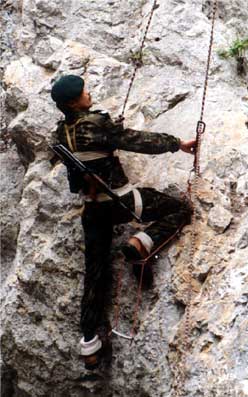
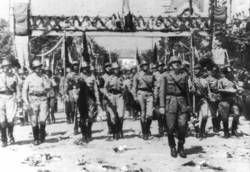
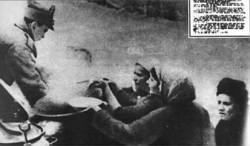
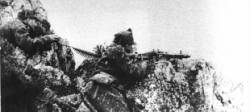
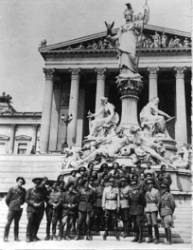
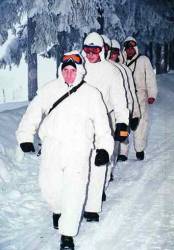
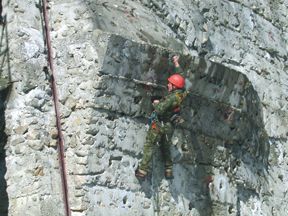
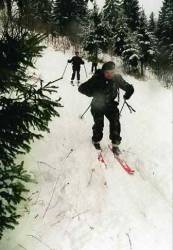
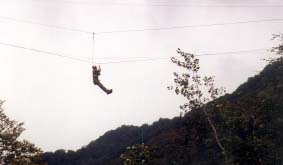 The camp is settled at the base of the Vidraru dam. For the conscripts, the first day of mountain training is deceavingly easy. They are mere spectators, watching as their instructors are doing all the hard work, building the camp and also simulating situations that could create panic among the soldiers. The second day, its the conscripts' turn to start the work. Climbing stiff rocks with the help of the hands alone, then with specific equipment, followed by peak traversing and rappeling proves them that their are not there to watch anymore.
The rappelling and the traversing provoke fear among the young conscripts. But only at first, as they soon discover they actually love to do it. The small number of conscripts from the city are more fearing than the majority of conscripts who were drafted from mountain villages.
The camp is settled at the base of the Vidraru dam. For the conscripts, the first day of mountain training is deceavingly easy. They are mere spectators, watching as their instructors are doing all the hard work, building the camp and also simulating situations that could create panic among the soldiers. The second day, its the conscripts' turn to start the work. Climbing stiff rocks with the help of the hands alone, then with specific equipment, followed by peak traversing and rappeling proves them that their are not there to watch anymore.
The rappelling and the traversing provoke fear among the young conscripts. But only at first, as they soon discover they actually love to do it. The small number of conscripts from the city are more fearing than the majority of conscripts who were drafted from mountain villages.
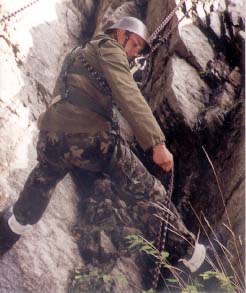 After a week of mountain training, the conscripts leave the Keys and embarque on a 20 km march to the small river flow of the Valsan. The living conditions here are better, they get to stain in cabains compared to tents in the previous camp, but the disadvantage is a daily 9 kilometer walk to and from the firing range. In all these marches the conscripts are accompanied by their commanders.
After a week of mountain training, the conscripts leave the Keys and embarque on a 20 km march to the small river flow of the Valsan. The living conditions here are better, they get to stain in cabains compared to tents in the previous camp, but the disadvantage is a daily 9 kilometer walk to and from the firing range. In all these marches the conscripts are accompanied by their commanders.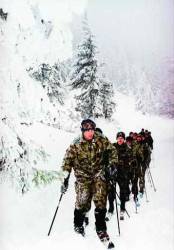
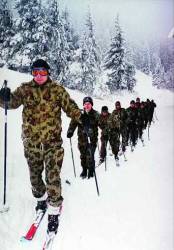
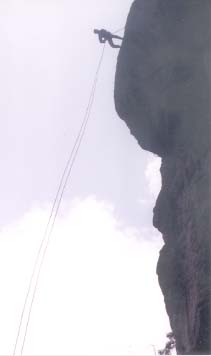 On the almost vertical rocks, the climbers from the 17th VM battalion from Vatra Dornei (north Romania), lead by colonel Ioan Gaftone, are coming down. Ninety percent of the members of this battalion are recognized climbing experts and all of them have the 1st class climber degree.
On the almost vertical rocks, the climbers from the 17th VM battalion from Vatra Dornei (north Romania), lead by colonel Ioan Gaftone, are coming down. Ninety percent of the members of this battalion are recognized climbing experts and all of them have the 1st class climber degree.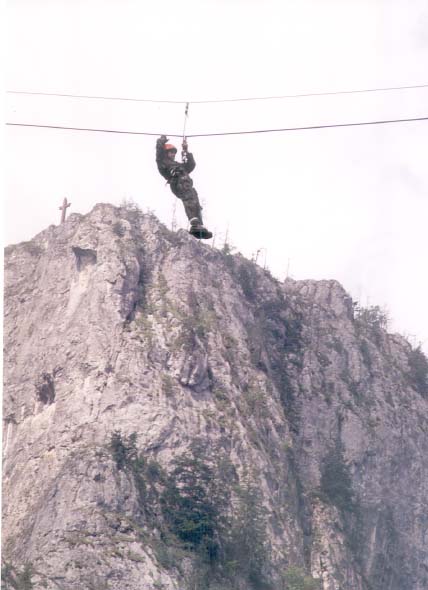 But the VM's from the other battalions are also acting bravely. If they didn't had the same experience as their collegues from Vatra Dornei, they try to gain it here, by watching and asking the experts.
But the VM's from the other battalions are also acting bravely. If they didn't had the same experience as their collegues from Vatra Dornei, they try to gain it here, by watching and asking the experts.
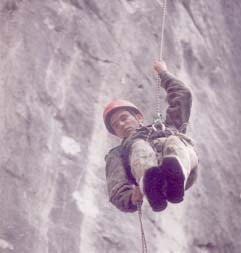 The teamwork can be felt in the air. Nobody acts alone, no matter how experienced they are, and there is no such thing as a "show-off", as you so often see in American movies. This is not a cheap Hollywood movie. One, no matter how much of experience he might have, can very easily die here. One centimeter in the wrong place, and you become a 75 kilograms diving bomb into nothingness.
The teamwork can be felt in the air. Nobody acts alone, no matter how experienced they are, and there is no such thing as a "show-off", as you so often see in American movies. This is not a cheap Hollywood movie. One, no matter how much of experience he might have, can very easily die here. One centimeter in the wrong place, and you become a 75 kilograms diving bomb into nothingness.